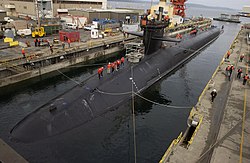 Ohio-class SSBN profile | |
 USS Ohio, during her commissioning ceremony in 1981. | |
| Class overview | |
|---|---|
| Name | Ohio class |
| Builders | General Dynamics Electric Boat [1] |
| Operators | |
| Preceded by | Benjamin Franklin class |
| Succeeded by |
|
| Cost | $2 billion (late 1990s) [5] ($3.62 billion in 2024 dollars [6] ) |
| Built | 1976–1997 |
| In commission | 1981–present |
| Planned | 24 |
| Completed | 18 |
| Canceled | 6 |
| Active | 18 |
| General characteristics | |
| Type | SSBN/SSGN (hull design SCB-304) [7] |
| Displacement | |
| Length | 560 ft (170 m) [1] |
| Beam | 42 ft (13 m) [1] |
| Draft | 35.5 ft (10.8 m) maximum [8] |
| Propulsion | |
| Speed | |
| Range | Limited only by food supplies |
| Test depth | +800 ft (240 m) [10] |
| Complement | 15 officers, 140 enlisted [1] [5] |
| Sensors & processing systems | |
| Armament | 4 × 21 inch (533 mm) Mark 48 torpedo tubes (Forward Compartment 4th level) |
| General characteristics (SSBN-726 to SSBN-733 from construction to refueling) | |
| Armament | 20 [a] × Trident I C4 SLBM with up to 8 MIRVed 100 ktTNT W76 nuclear warheads each, range 4,000 nmi (7,400 km; 4,600 mi) |
| General characteristics (SSBN-734 and subsequent hulls upon construction, SSBN-730 to SSBN-733 since refueling) | |
| Armament | 20 [a] × Trident II D5 SLBM with up to 12 MIRVed W76 (100 ktTNT) or up to 8 MIRVed W88 (475 ktTNT) nuclear warheads each, range 4,000 nmi (7,400 km; 4,600 mi) |
| General characteristics (SSGN conversion) | |
| Armament | 22 tubes, each with 7 Tomahawk cruise missiles, totaling 154 |
The Ohio class of nuclear-powered submarines includes the United States Navy's 14 ballistic missile submarines (SSBNs) and its 4 cruise missile submarines (SSGNs). Each displacing 18,750 tons submerged, the Ohio-class boats are the largest submarines ever built for the U.S. Navy and are capable of carrying 24 Trident II ballistic missiles or 22 tubes with 7 BGM-109 Tomahawk cruise missiles apiece. They are also the third-largest submarines ever built, behind the Russian Navy's Soviet era 48,000-ton Typhoon class, the last of which was retired in 2023, [b] [14] and 24,000-ton Borei class. [15]
Contents
- Description
- History
- SSBN/SSGN conversions
- Missile tube reduction
- Detailed cross-section
- Boats in class
- Replacement
- In popular culture
- See also
- Notes
- References
- Bibliography
- Further reading
- External links
Like their predecessors the Benjamin Franklin and Lafayette classes, [16] the Ohio-class SSBNs are part of the United States' nuclear-deterrent triad, along with U.S. Air Force strategic bombers and intercontinental ballistic missiles. [17] The 14 SSBNs together carry about half of U.S. active strategic thermonuclear warheads. Although the Trident missiles have no preset targets when the submarines go on patrol, [18] : 392 they can be given targets quickly, from the United States Strategic Command based in Nebraska, [19] using secure and constant radio communications links, including very low frequency systems.
All the Ohio-class submarines, except for USS Henry M. Jackson, are named for U.S. states, which U.S. Navy tradition had previously reserved for battleships and later cruisers. The Ohio class is to be gradually replaced by the Columbia class beginning in 2031.





